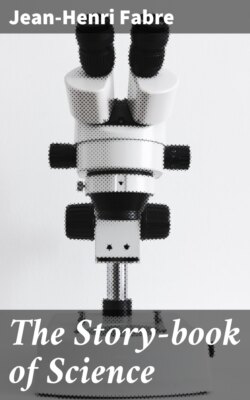Читать книгу The Story-book of Science - Fabre Jean-Henri - Страница 16
CHAPTER XIII
METAL PLATING
ОглавлениеIN the morning some wandering coppersmiths were passing. Mother Ambroisine had sold them the old kettle. Besides the sale, they were to make over the lamp whose foot had melted on the stove, and replate two saucepans. So the smiths lighted a fire in the open air, set up their bellows on the ground, and in a large round iron spoon melted the old lamp, adding a little tin to replace what had been lost. The melted metal was run into a mold, from which it came out in the shape of a lamp. This lamp, still pretty large, was fixed on a lathe which a little boy set in motion; and while it turned, the master touched it with the edge of a steel tool. The tin thus planed off fell in thin shavings, rolled up like curl-papers. The lamp was visibly becoming perfect; it took the proper polish and shape.
Afterward they busied themselves plating the copper saucepans. They cleaned them thoroughly inside with sand, put them on the fire, and, when they were very hot, went over the whole of their surface with a tow pad and a little melted tin. Wherever the pad rubbed, the tin stuck to the copper. In a few moments the inside of the saucepan, red before, was now shiny white.
Emile and Jules, while eating their little lunch of apples and bread, looked on at this curious work without saying a word. They promised themselves to ask their uncle the reason for whitening the inside of the copper saucepans with tin. In the evening, accordingly, they spoke of the tinning and plating.
“Highly cleaned and polished iron is very brilliant,” explained their uncle. “The blade of a new knife, Claire’s scissors, carefully kept in their case, are examples. But, if exposed to damp air, iron tarnishes quickly and covers itself with an earthy and red crust called—”
“Rust,” interposed Claire.
“Yes, it is called rust.”
“The big nails that hold the iron wires where the bell-flowers climb up the garden wall are covered with that red crust,” remarked Jules; and Emile added:
“The old knife I found in the ground is covered with it too.”
“Those large nails and the old knife are encrusted with rust because they have remained for a long time exposed to the air and dampness. Damp air corrodes iron; it becomes incorporated with the metal and makes it unrecognizable. When rusty, iron no longer has the properties that make it so useful to us; it is a kind of red or yellow earth, in which, without looking attentively, it would be impossible to suspect a metal.”
“I can well believe it,” said Jules. “For my part, I should never have taken rust for iron with which air and moisture had become incorporated.”
“Many other metals rust like iron; that is to say, they are converted into earthy matter by contact with damp air. The color of rust varies according to the metal. Iron rust is yellow or red, that of copper is green, lead and zinc white.”
“Then the green rust of old pennies is copper rust,” said Jules.
“The white matter that covers the nozzle of the pump must be lead rust?” queried Claire.
“Exactly. The prime difficulty with rust is that it makes metals ugly: they lose their brilliance and polish; but it works still greater injury. There are harmless rusts which might get mixed with our food without danger: such is iron rust. On the contrary, copper and lead rusts are deadly poisons. If, by mischance, these rusts should get into our food, we might die, or at least we should experience cruel suffering. We will speak only of copper, for lead, on account of its quick melting, cannot go on the fire and is not used for kitchen utensils. Copper rust, I say, is a mortal poison; and yet they prepare food in copper vessels. Ask Mother Ambroisine.”
“Very true,” said she, “but I always have my eye on my saucepans: I keep them very clean and from time to time have them replated.”
“I don’t understand,” put in Jules, “how the work that the tinsmith did this morning could prevent the copper rust being a poison.”
“The smith’s work will not make the copper rust cease to be a poison,” replied Uncle Paul, “but it will prevent the rust’s forming. Of the common metals tin rusts the least. Exposed to the air a long time, it scarcely tarnishes. And then the rust, which forms in small quantities, is innocuous, like iron rust. To prevent copper from covering itself with poisonous green spots, to preserve it from rust, it must be kept from contact with damp air and also with certain alimentary substances such as vinegar, oil, grease—substances that provoke the rapid formation of rust. For this reason the copper saucepan is coated over with tin inside. Under the thin bed of tin which covers it, the copper cannot rust, because it is no longer in contact with the air. The tin remains; but this metal changes with difficulty, and, besides, its rust, if it forms any, is harmless. So they plate copper, that is to say they cover it with a thin bed of tin, to prevent its rusting, and thus to prevent the formation of the dangerous poison that might, some day or other, be mixed with our food.
“They also tin iron, not to prevent the formation of poison, for the rust of this metal is harmless, but simply to preserve it from changing and covering itself with ugly red spots. This tinned iron is called tin-plate. Lids, coffee-pots, dripping-pans, graters, lanterns, and innumerable other things, are of tin-plate; that is to say, thin sheets of iron covered on both sides with a coating of tin.”
